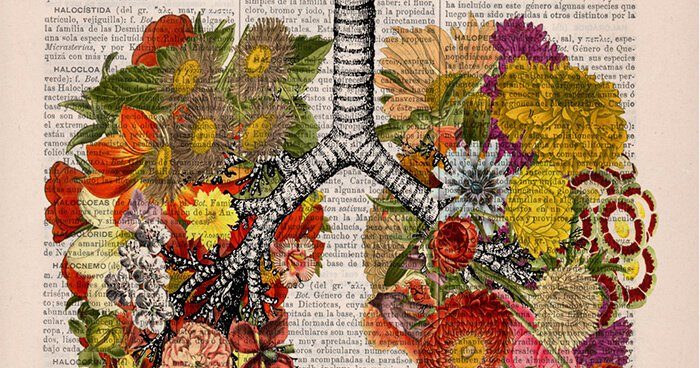The ancients connected with the breath more closely as the breath of life, or the supreme life force: the waves that ride back and forth, connecting us with the universe. If you've ever been stressed or anxious, the first thing that deserts you is the breath, your chest tightens and as the lack of oxygen hits your body; your anxiety increases. If I think back to times of stress where someone has told me to, 'Just breathe' - it was the last thing my overactive mind and nervous system wanted to hear, but it was probably the best thing I could have done for myself.
Breath can be a gauge of life force and it is the only autonomous bodily function that we can control. The breath moves through our body from birth until death, but it often becomes shallower over time. This tends to be the default, unless we consciously shift it. With so much tied up in our breath - and the simple gift of being able to work with this most potent of autonomic functions - it's worth exploring the benefits of rethinking how we breathe.
The quality and quantity of life force, or prana, and the way it flows through the physical and subtle bodies, has the ability to enhance or inhibit human wellbeing. We can't even survive more than four minutes without breathing. The oxygen that is provided to all the organs and cells of the body comes through the humble breath. So how best can we maximise our breathing potential?For breath is life, and if you breathe well you will live long on earth. ~ Sanskrit Proverb
The Interconnectedness of the Body, Mind and Emotions
The emotions and thoughts of the mind are closely linked to the breath. It's the universal law of correspondence at work. The Yoga Sutras of Patanjali says when you control your breath, you can control your mind and emotions. A recent study conducted by Stanford Scientists confirms this link between the breath and states of being. There is a group of neurons in the brain responsible for the respiratory system which connect breathing to states of mind. This small neuronal subpopulation works as a breathing rhythm generator sending signals directly to the centre of the brain, and subsequently playing a key role in stress, attention and alertness.
This scientific knowledge makes a lot of sense when we correlate it back to our experiences. Shallow, quick or rapid breathing is often a symptom of someone experiencing anxiety or stress. When the mind is calm, the breath follows with an even, slow pace. When someone is angry, their breath can become forceful and rapid, when depressed or despondent - sighing and depletion sets in, and when in pain, people tend to gasp. Of course, there are variations on these experiences, but we do tend to shift the way we breathe as different emotions arise.
Many people have experienced the clarity and power of focused breathing and studies have shown that yogic breathing has a powerful effect on stress, helps fight depression, and improves sleep and overall wellbeing; while also supporting immune function and rapid recovery from illness.
Benefits of Breathing Techniques
There's also a physiological link. Human adults take approximately 12 to 16 breathing cycles per minute. But asthmatics or people who hyperventilate can take double this amount, which results in taking in too much oxygen and then expelling too much carbon dioxide (CO2). When there is less CO2 the person breaths more rapidly because they cannot get as much oxygen. This makes the breathing cycle rapid. This is generally characterised by inhaling air and directly expanding the breath, which is called horizontal or shallow breathing.
Vertical breathing is its counterpoint, also known as diaphragmatic or belly breathing. Various methods, like the Wim Hoff or Tummo meditation, have become increasingly popular in demonstrating how the body can strengthen and adapt using breathing practices. Scientists from the United States studied Tibetan Tummo meditators' control of 'inner energy' after hearing accounts that wet sheets wrapped around meditators would dry and steam during the meditation. The study concluded that combining the forceful breath practices, and meditative visualization to regulate body temperature, could be applied to improve health and cognitive performance in everyday people.
So how do we cultivate the breath to get these physical, mental and emotional benefits? You may have noticed lots of yoga instructors guide people to breathe predominantly through the nostrils. There are a few reasons for this. One practical reason is because we can consciously control how much air is being inhaled and expelled. If the breathing moves to the open mouth we may subtly shift into stressing or pushing our bodies, which is not aligned with the ease and balanced effort one is intending to practice. The efficiency and ease with which the breath flows through us is a telling process to witness. We can then use our breath to empower, rather than oppose.
4 Steps to Breathing ConsciouslyFeelings come and go like clouds in a windy sky. Conscious breathing is my anchor. ~ Thích Nhất Hạnh
Rhythmic breathing techniques are called Pranayama in yoga. Pranayama is a yogic science of using the prana, or life force of breath, to control the body and mind. Deliberate rhythmic breathing can be found in various traditions. These voluntary breathing exercises create a bridge to positively influence the involuntary bodily functions. This conscious efficiency results in more oxygen supply, regulation of heart rates, blood pressure, circulation, and organ function.
There are plenty of breathing techniques for different purposes but there are four simple principles, which underpin most pranayama techniques:
- Inhalation,
- Full retention or holding of the breath after inhalation,
- Exhaling; and
- Empty retention or holding the breath after exhaling.
The Yogi rule for Rhythmic Breathing is that the units of inhalation and exhalation should be the same, while the units for retention and between breaths should be one-half the number of those of inhalation and exhalation. ~ The Science of Breath, by Yogi Ramacharaka, Chapter 13, Page 63, 1904Focus on inhaling and exhaling through the tip of the nose, observe the rhythm and retention of the breath; the gap. It's useful to create a count to find a cycle. This is what's meant by rhythm. For instance, inhale for seven counts, retain or hold for one, exhale for six counts and hold for three. This is one cycle. Enormous amounts of prana are drawn into the body during inhalation, but remember, holding the breath after exhaling heralds the full benefit.
An Extra Step for a Deeper Practice
There's another key, which can be used to enhance some pranayama, meditation and relaxation practices. In the Hindu tradition, some yogis called it Khechari Mudra, the practice of curling the tongue and connecting it to the palate. In traditional Chinese medicine, the primary yang meridian, the Governing Channel, is in the palate, and the primary yin meridian, the Conception Channel, ends at the tip of the tongue. By connecting the tongue to the palate, an energetic circuit of the front and back meridian channels is created. This not only strengthens the energy body, it is also intended to stimulate the meridian connection point and associated master glands, the pituitary and pineal. This is another simple practice that you can do, right in the comfort of your own mouth.
Thankfully, new breathing processes can be learned and applied in a short amount of time, making it a useful self-care tool. By intentionally using your breath, you open up new possibilities to actively contribute to your physical, mental and emotional wellbeing. The air moving through you has great potential. Breath is at your service.








Comment: Deep breathing exercises can improve your life: